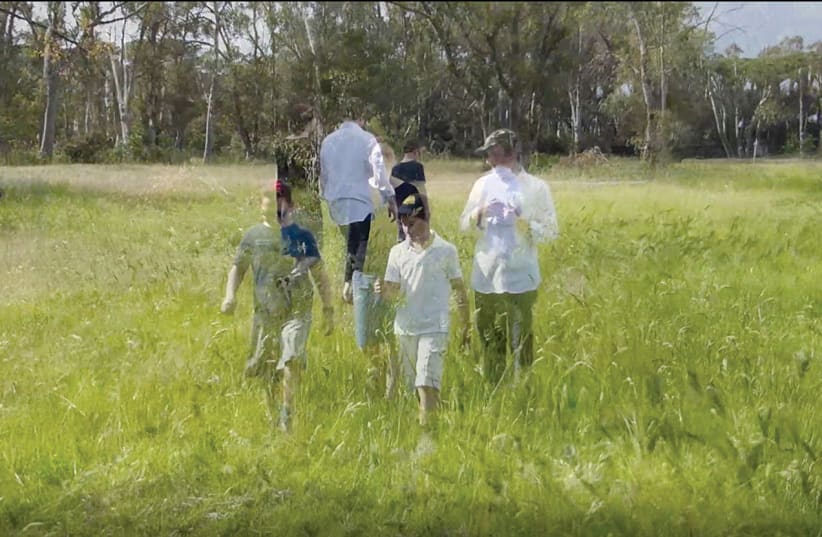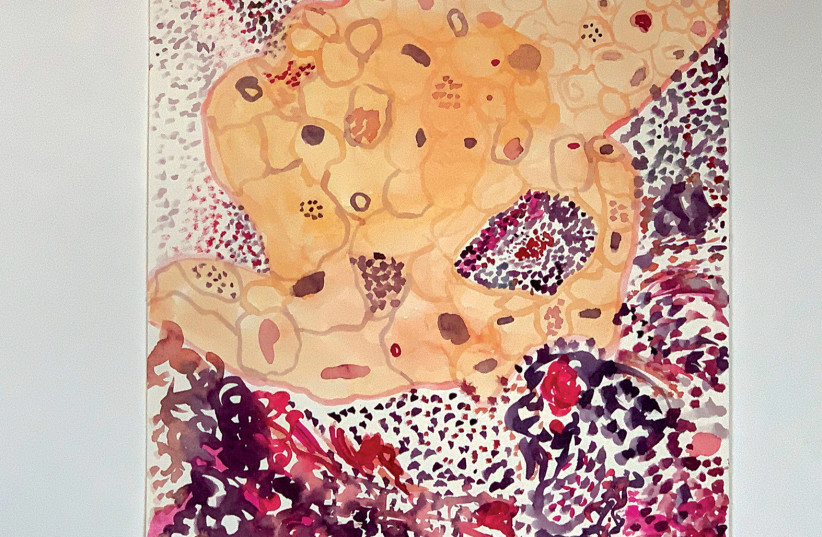Ruth Schreiber calls her latest exhibition, at the Agripas 12 collective gallery, Ta’aroch – Prepare. The direct reference is Psalm 23, which should be familiar to anyone who has attended a Shabbat synagogue service, or sat down to a se’udat shlishit Shabbat afternoon meal when it is traditionally sung. The relevant verse opens with: “You prepare a table before me,” hence the exhibition title, which alludes to the solace to be found in the belief that God is always watching over us, particularly in our hour of need.
The latter serves as Schreiber’s highly personal launching pad for the show, curated by Bitya Rosenak. “The idea [of using Psalm 23 as an artistic catalyst] has been percolating within me for a long time,” she explains. “Nearly 17 years ago now, my best friend, my lifelong friend, died of cancer. She went through all sorts of treatments, and she said Psalm 23 gave her comfort and strength. She used to say it over to herself.”
That memory brewed in Schreiber’s mind, and heart, and eventually came to artistic fruition. “That has really stayed with me and I decided to look at it from that point of view, to try to take a closer look at the words [of the psalm].”
Over the years, Schreiber has proven herself to be an incisive multidisciplinary artist. Her exhibitions address a range of burning existential issues and she is not afraid to set her stall out, and to point a probing finger at the establishment where she feels accepted behavior requires a rethink.
A few months ago, her Where do Babies Come From? showing at the Jerusalem Biennale homed in on the contentious issue of gender fluidity, sexuality, procreation and what constitutes the family nucleus in this day and age of technologically assisted advanced medical procedures, and other forms of intervention. A previous video work “Kasher Kasher Kasher” examined the mikveh ritual bathing practice of religious women, and asked what effect, if any, that has on the women’s life.
What is even more fascinating is that Schreiber is religious herself. She says she is not looking to set off any seismic waves in the community. “I don’t really feel I am a rabble-rouser, or would like to be. I feel I am shining a light here and there.”
Ta’aroch is a different kettle of fish. It largely follows an autobiographical timeline. “I went to a [non-Jewish] girls’ grammar school in Mill Hill [in London],” Schreiber recalls. “It was a very good school and they taught us Psalm 23 and other bits [of the Bible] by heart. I knew it by heart in English before I knew it in Hebrew,” she chuckles.
The psalm gets another airing at the Agripas 12 exhibition, which opened March 3 and runs until April 2.GIVEN SCHREIBER’S propensity for employing several forms of art to get her message across, unsurprisingly the exhibition comprises works from different areas of creative pursuit, including photography, video clips, installations and watercolor paintings.
There is a strong oxymoronic thread to the show. The paintings allude to biological dynamics and the ramifications of physical health malfunctions. On the other hand, the photos appear to convey a sense of “normality,” of the quotidian flow continuing unabated, almost blithely disregarding the possibility that there may be people in less fortunate circumstances who are not able to benefit from the perceived natural order of things.
That may be so but, as far as Schreiber is concerned, the thematic anchor for Ta’aroch is the textual content of Psalms 23 and the images that conjures up for her. “I took different parts from the psalm,” she states, referencing the verse: “He makes me lie down in green pastures; he leads me beside still waters.”
One print shows the Yarkon River, and another is of a tranquil verdant spot, albeit with somewhat disturbing semi-transparent figures ghosting through the greenery. They are basically snapshots of definitively ordinary life. “People walk by still waters, walk their dogs or sit on a bench,” Schreiber notes.
In the meantime, things may be very different for others, for people we cannot see in the photographs. While, for example, Tel Avivites enjoy a stroll through the park, out of eyeshot and beyond the view of the camera lens there may be people coming to the end of their mortal coil or battling all kinds of life-threatening and challenging situations.
Clearly the show must, and does, go on. “It is really about the cycle of life and lots of people doing lots of things at different times,” says Schreiber. That multifaceted element, she feels, resonates in King David’s text. “This particular psalm has contradictory parts to it. You have the green pastures and still waters, and then suddenly you are in the shadow of the valley of death, which all of us fear.”
Schreiber says there is a lot to dig into. “What does it mean to ‘prepare a table before me in the presence of my enemies’?” That may impart wider, very real, existential components of life in these here parts.
“Is that what we are doing here in Israel?” she speculates. “Are we laying our table in the presence of our enemies?” For that matter, what does Schreiber think laying one’s table implies? “I don’t know. Is that to sit and eat, and carry on? Is that some people are doing this, and some people are doing that? I don’t know.”
Fair enough, after all, artists are supposed to be more adept at proffering posers than providing the answers. Perhaps this harks back to the age-old humoristic grounds for our religious holidays: they tried to kill us, they didn’t, let’s eat? “I’m not sure about that,” Schreiber says. “I think I was being quite literal when I was going through the parts of the psalm. I wondered what each bit meant.”
That verbatim take also impacted the creative process. “I have a cup overflowing [in the exhibition]. It is really quite literal. I have a cup overflowing with wine, with a pump recycling the wine.” Sounds like a nice, easy on the eye illustrative touch.
I wondered whether Schreiber who, to put it delicately, is past her first flush of youth is also indicating the ever-clearer certainty that this stage of our corporeal existence does, in fact, end. “I think about that the whole time,” she admits, “but I don’t think that is what I am saying in this particular exhibition.”
Despite the passing of Schreiber’s close friend, she says Ta’aroch has a sunnier side to it. “It’s more an appreciation of life, different parts of life.” It is also very much a home-cooked rollout. “All the models for my work, in my videos, for example, are my children and grandchildren. I put them to work,” she laughs. “Free models, those that are willing.”ROSENAK WAS willing and able to help Schreiber sort out her creations and put them into some logically communicative order at the gallery.
Naturally, as befits the curatorial role, she brought her own understanding and interpretations of the exhibits to the fray which are not necessarily in complete sync with the artist’s intent or mindset.
In her notes to the show she posits that “Schreiber’s thought-provoking work inspires criticism and dissent, with themes derived from the cycle of life. Her discourse within her own environment, the modern orthodox Jewish community, is close and painful. She is a product of this space, and she continues to challenge it from within.”
In contrast to the artist’s more measured tones, and true to the yin-yang spirit behind Ta’aroch, the curator feels there are some more feral undercurrents to the show. “It is surprising that Ruth created ‘Even though I walk through the shadow of the valley of death.’ After she related the story of her friend, who suffered so terribly, what does she paint? She makes pleasant watercolor paintings, of close-ups of diseases.”
Pleasant? That epithet seems to pertain to the eye of the beholder league. “You are talking about paintings which, in fact, look abstract, and I look at them and I see red and yellow and orange, and circular shapes. There is nothing there that looks threatening. That is where the irony is.”
Rosenak takes her interpretive stance a step further. “It might be that there is some degree of criticism, in these works, of [conventional] medicine which always only relates to the sick organ, or, in even worse instances, only to the disease instead of to the person who is suffering, and others who are close to the sick person who is suffering, and to their fears and that sort of thing.”
The curator deciphers Schreiber’s left-field approach to conveying that ambiance. “I think she presents that, in an ironic way, as the aesthetic photogenic disease and she feels it is not appropriate to show it as suffering.” The observer has to put in a shift, in order to get a better handle on the underlying message below the appealing surface.
“She didn’t paint a sick person in bed with his loved ones by his side. Perhaps that imparts an inability to deal fully with the pain, and so she escapes into these aesthetics. In the paintings, she is ambivalent about relating to the subject matter.”
Rosenak is not convinced that reticence is necessarily a reflection of Schreiber’s desire to keep illness at arm’s length. “That may be Ruth’s criticism of the way [conventional] medicine and science operate.”
The ebb and flow ethos also informs the curatorial setup over at the gallery.
The first room welcomes the visitor with a no-punches-pulled demeanor, after which the second display area will come as some relief with the biblical green pastures represented by ordinary synthetic grass.
“This element is reminiscent of Schreiber’s ‘Garden of Eden’ – a large wall covered with plastic flowers,” Rosenak notes, returning to the counterbalance approach. “That expresses the falsity of the Garden of Eden, conveying the disquieting integration of simple, everyday beauty and repugnance.”
The visitor eventually gets to see the implied titular piece of furniture, the prepared table. Once again an oxymoronic feel filters through. “Ruth did not go for a majestic table in a palace,” says Rosenak. “She placed a camera over the table. It is a simple normal meal and you don’t see the people, only their hands, and the food.” Like most of the exhibits, that leaves plenty to our imagination, and invites us to take the narrative any which way we like.
“This is the introduction to a discussion about real life,” Rosenak declares.
SCHREIBER AND Rosenak are both longtime members of the Agripas 12 cooperative, which came into being almost 18 years ago. Rosenak feels the group offers rewards for all the artists involved.
“The cooperative draws everyone into Israeli art in the wider sense. We try to run outside events too, like having a large group exhibition at the Castel Museum [in Ma’aleh Adumim]. These are initiatives of the group members,” she says.
There is also a sense of mutual support between the artists which, naturally, has been particularly important these past couple of years. “This is the first communal gallery in Israel,” Rosenak notes. “We have lots of gatherings and artist talks. We discuss art and each of us expresses our thoughts and feelings.”
That is quite a boon for the artist who generally creates in their cloistered studio which, while enabling them to shut out distractions, also cuts them off from the very world they are looking to portray.
Yet another reason to rejoice in this special Jerusalemite gallery. ❖
For more information: agripas12gallery.com

